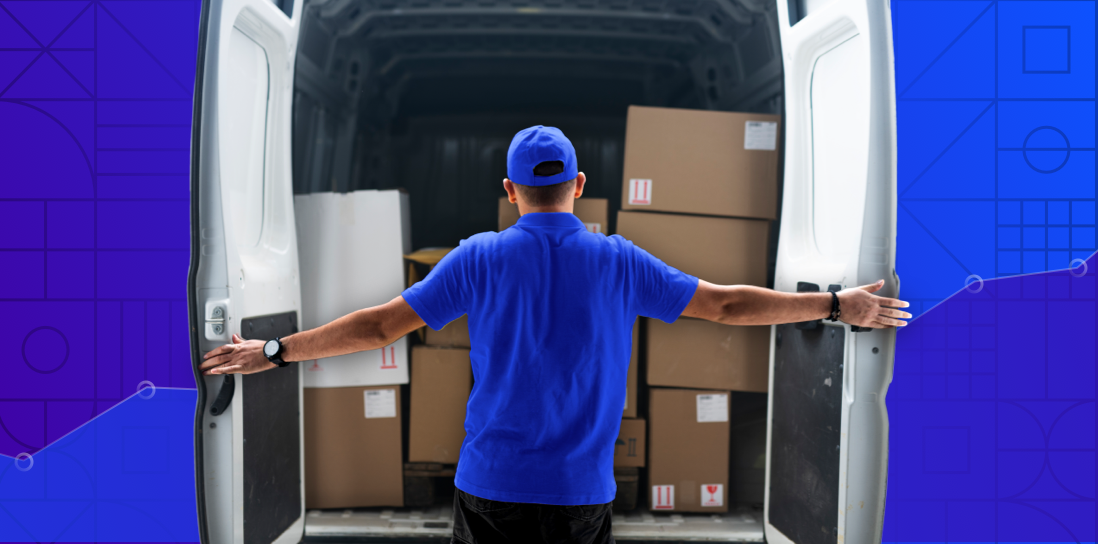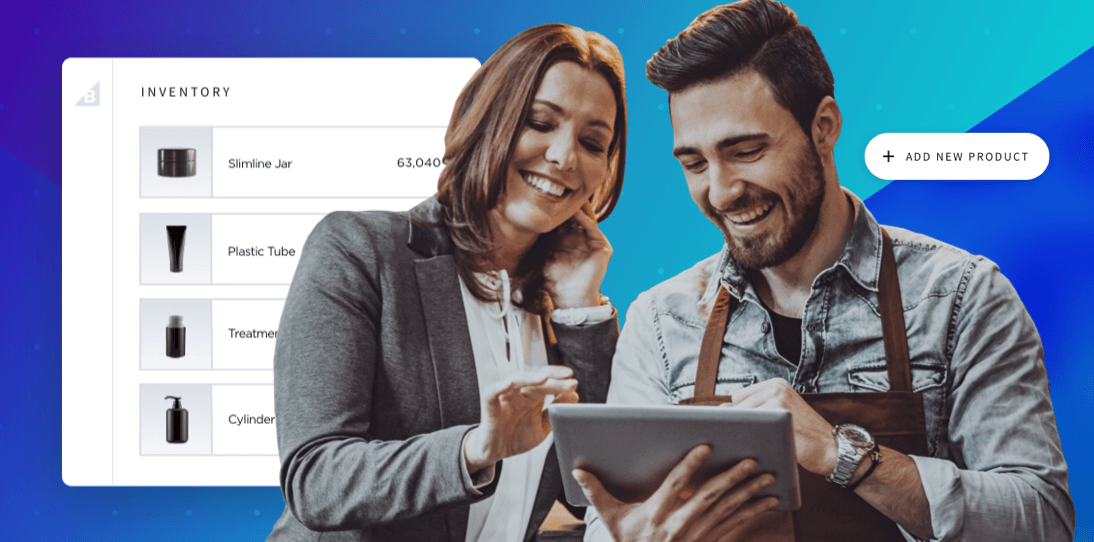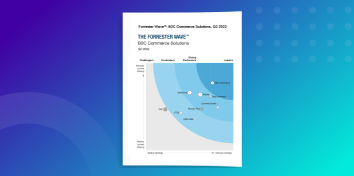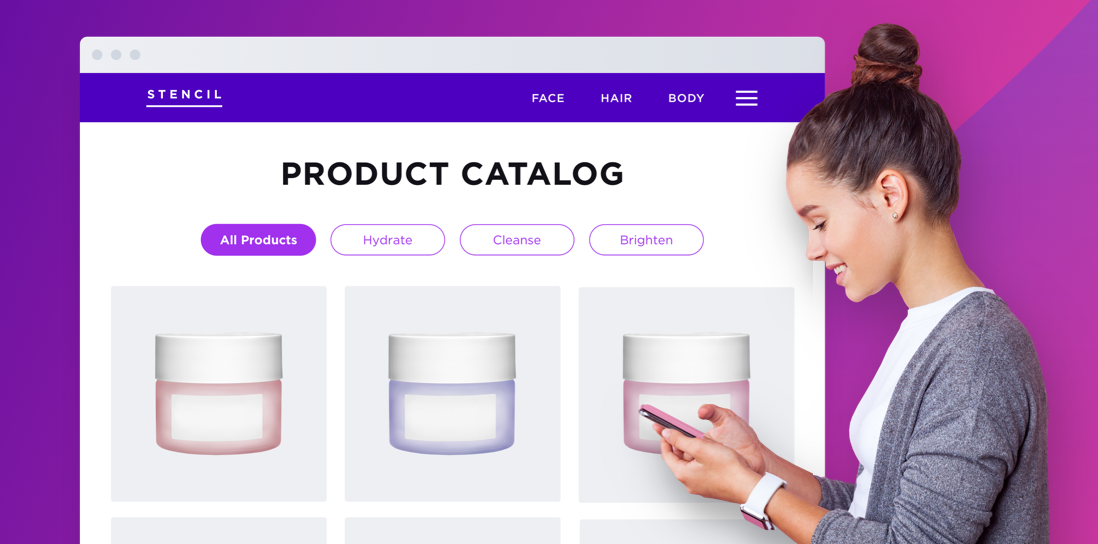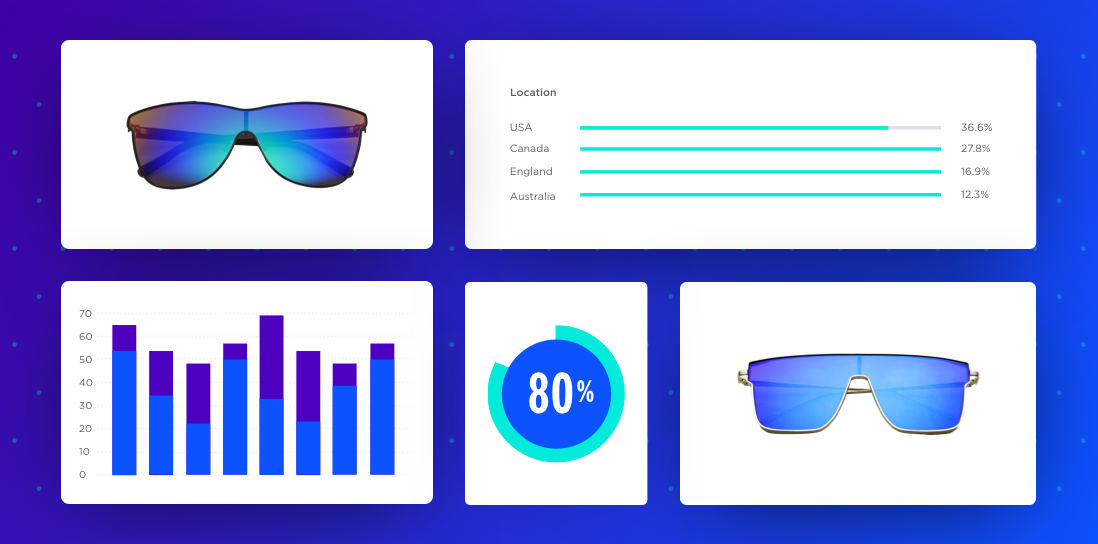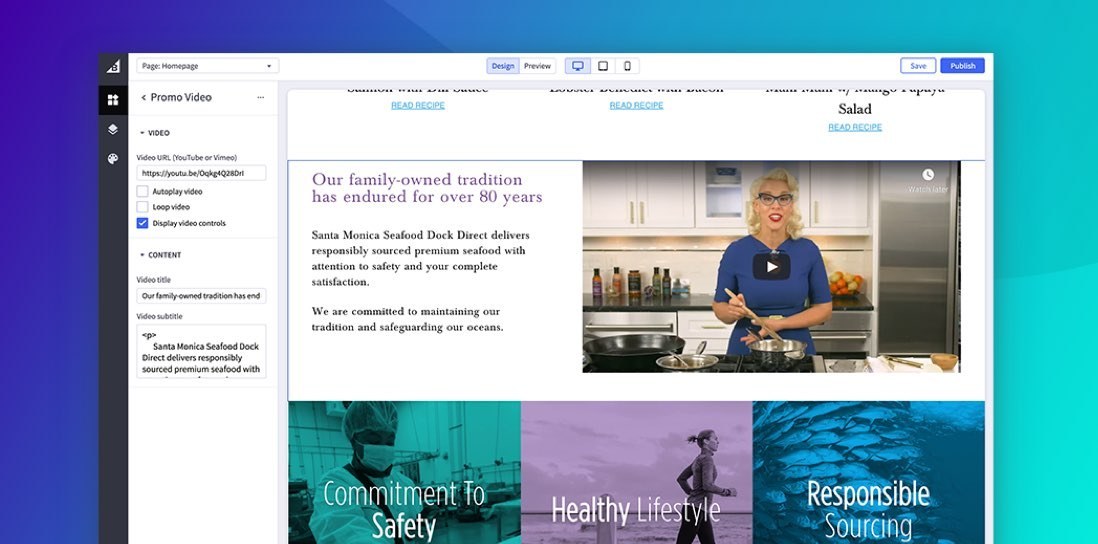- Enterprise
- Essentials
B2B Ecommerce
The B2B ecommerce space is growing fast and buyers have high expectations. Let's take a look at the different types of B2B ecommerce, as well as common misconceptions and some success stories.
Your B2B Shopping Experience. Introducing BigCommerce B2B Edition
Featured B2B Ecommerce Resources
B2B Ecommerce: Learn Everything You Need to Know
In 2020, the global B2B ecommerce market was valued at $14.9 trillion — over five times that of the B2C market. On top of that, Forrester predicts that B2B ecommerce will account for 17% of all B2B sales in the U.S. by 2023, reaching $1.8 trillion.
Needless to say, B2B ecommerce is reaching new heights.
B2B ecommerce, or business-to-business electronic commerce, is the sale of goods or services through online transactions between businesses. Because orders are processed digitally, buying efficiency and effectiveness is improved for wholesalers, manufacturers, distributors and other types of B2B sellers.

Historically, B2B businesses have been slow to adopt ecommerce. Just before the pandemic, an eMarker report found that only 9% of total B2B U.S. product sales occurred via an ecommerce website.
However, with the pandemic as a catalyst for change and an increasing number of millennials entering the B2B space, buyer expectations are rising faster than ever, and B2B companies need to stay up to speed.
Fading are the days of cold calling, offline marketing activities and paper-based, manual transactions. Just as the B2C world is constantly innovating and digitizing, customers seek these same experiences from B2B sellers — and grow increasingly impatient with those that don’t provide them.
In fact, 80% of B2B buying decisions depend on a buyer’s direct or indirect customer experience, and 87% of B2B buyers would pay more for a supplier with a better ecommerce portal and experience, an increase from 81% in 2020 and 74% in 2019.
In the midst of an evolving landscape, B2B merchants are left to decipher the modern B2B buyer’s needs. But if you’re a B2B business stuck in legacy systems, making a digital transformation may be a daunting endeavor. To help you begin modernizing your B2B business, this guide will walk you through the basics of B2B ecommerce, including marketing tips, common misconceptions, advantages of having a B2B platform and some helpful examples from our own BigCommerce B2B merchants.
Free B2B Masterclass
Want to grow B2B online sales faster? Start now by enrolling in our free B2B Masterclass.
Get StartedTypes of B2B Ecommerce
According to Gartner, by 2025, 80% of B2B sales transactions between buyers and suppliers will occur via digital channels.
Plus, emerging ecommerce technologies are reducing the barrier to entry for traditionally B2C businesses to add a B2B component (B2C2B) and, vice versa, for traditionally B2B companies to sell direct-to-consumer (B2B2C).
As a B2B business, you’ll likely fall into one of the following categories. Each entity has its own advantages and disadvantages, and some businesses may even fall into several categories at once.
B2B2C.
Business-to-business-to-consumer (B2B2C) ecommerce takes out the middleman usually between the B2B organization and the B2C, putting the businesses directly in contact with the consumer. The B2B2C model can best be described by looking at how a wholesaler or manufacturer interacts with traditional B2B and B2C models.
In those cases, the wholesaler or manufacturer sends goods to the B2B, and those goods are then sold to the final consumer. In a B2B2C model, the wholesaler or manufacturer reaches the final consumer by either partnering with the B2B or directly selling to the consumer. With B2B2C ecommerce, these transitions happen online, often through virtual storefronts, an ecommerce site or even apps.
In many B2B2C ecommerce models, the consumer knows they are getting products from a business that’s separate from where they purchased it.
For example, the consumer may purchase a product from an affiliate blogger, but the product is branded and sent by the manufacturer.
Wholesale.
Businesses often buy goods in bulk for a lower price and turnaround to sell them at retail value, and the goods are usually purchased directly from the manufacturer or distributors. This form of B2B, called wholesale, could also be described as the sale of goods to other businesses.
Wholesale B2B models are present in many industries including retail, food service, construction and medical, among many others. Traditionally, wholesale B2B transactions occur over the phone, via email or by way of spreadsheet order forms.
With wholesale ecommerce, everything is digital using a B2B ecommerce platform. The platform allows the wholesaler to display products more easily and creates a seamless buying experience.
One reason the B2B ecommerce market is expanding is a result of B2Cs making the switch. While it's possible to make the transition, there's a bit of a learning curve. B2B transactions tend to be larger than B2C purchases, and B2B sales often rely on long-standing relationships with vendors.
Manufacturers.
Manufacturers produce finished goods on a large scale by utilizing parts and raw materials in combination with manual labor and machines. In a B2B model, the finished goods are sold to other manufacturers, suppliers or wholesalers.
The auto industry is a good example of manufacturers in a B2B arena. The manufacturer creates individual car parts, such as a fuel pump and an engine. Then, the manufacturer sells these parts to an automotive company that builds the entire car from the parts and sells it to the consumer.
In the same way that wholesalers are taking business online, manufacturers are, too. According to The State of International Ecommerce Report, over a third of manufacturers projected a growth of at least 25% in B2B ecommerce sales throughout 2021 and 2022.
On top of that, 54% of manufacturers want to sell directly to consumers. Without a doubt, B2B buyer expectations are shifting, and manufacturers need to stay up to pace.
But it isn’t just B2C customers who have higher expectations. Wholesalers, distributors and channel partners are also seeking out manufacturers that provide digital buying options, including the ability to view pricing and check order statuses online.
Distributors.
After a product goes through the hands of a manufacturer, there are two options for the next step: If the manufacturer prefers to have more control over the selling aspect of their business, they can sell directly to the end customer. However, this leaves responsibilities such as managing orders, packaging and marketing in their hands.
On the other hand, a manufacturer can partner with a distributor to sell their product for them. In this case, the distributor works closely with manufacturers in an effort to bring visibility to the goods they are producing, with the goal of increasing sales and moving their product along the distribution channel.
In an ecommerce model, the logistics of the sale happen online, often through an ecommerce platform, which creates greater opportunity for growth. Just like other B2B models, distributors are working to shorten the lead time from sale to delivery and create a customer experience that beats customer expectations.
Online marketplaces like Amazon, eBay and Walmart prove the huge potential for distributors to sell online and achieve unprecedented growth. In fact, the adoption rate of ecommerce distribution skyrocketed by a weighted 26.3% increase from 2019 to 2020. And with Amazon setting the precedent for automated, personalized experiences, distributors must incorporate more advanced ecommerce technologies in order to keep their customers’ attention.
Stages of B2B Business
If you’re a B2B business that’s just getting off the ground, or even if your B2B business doesn’t exist yet, it’s important to understand the four stages of B2B business growth. Being able to gauge what phase your business is in right now will help you prepare for the inevitable obstacles and resolve them quickly as they arise.
Just as a tree begins as a seedling and requires a different amount of resources in order to sprout and mature, your B2B business will go through several phases of business development, each requiring different finances, marketing strategies and resources.
Here we’ll walk through each of the four stages of becoming a B2B business, as well as the unique challenges of each.
New/Startup.
It all starts with an idea for a product or service and the dream to make a business out of it.
During the startup stage, you’ve decided to pursue your business venture and launch your B2B brand. At this point, you have finished developing your product or service and have begun marketing and selling it to customers.
Sales are often slim but slowly growing in this stage, and your business focus is likely on researching your target market and determining consumer segments. As you begin making your first sales, you’ll probably need to adjust your product or advertising based on initial customer feedback and demand.
As a result, you’ll hopefully be able to secure your marketing strategy and move on to the next phase of development.
Common Challenges
- Establishing a market presence.
- Establishing a target audience.
- Facing larger competitors.
- Managing cash reserves.
Growth.
After launching your product and getting your bearings, you’ll move into the growth, aka survival stage.
At this point, your business will pass your breakeven point and begin to see increasing profits, however not as high as your sales level. As your business generates more revenue and gains new customers, you’ll be able to cover operating expenses and explore new business opportunities.
However, this stage often brings increased competition, which will require you to revisit your business model and consider key activities such as sales model, marketing and operations.
Common Challenges
- Handling more customers.
- Managing increased revenue.
- Increased Competition.
Expansion.
Once you’ve established a presence in the B2B market, you’ll likely experience rapid growth in cash flow and revenue as you reach into new markets and distribution channels. However, this growth may begin to slow as the market becomes more saturated and new competitors steal market share.
To capitalize on growth, your B2B business will need to gain more market share and new sources of revenue, such as new product lines or target customers.
Common Challenges
- Increased competition.
- Creating new products and services.
- Expanding into new markets.
- Maintaining and growing your existing business.
Maturity.
Once your business has reached maturity and climbed to the top of the market, it’s likely that cash flows will taper off and profit margins will become thinner. While your business may be dominating and still expanding, it’s probably not at the same rate as in the expansion stage.
At this point, it’s your decision to whether to form an exit strategy or reinvent yourself as a B2B business. By investing in new ecommerce technologies and exploring new markets, your business has the potential to extend its life cycle and step back into the expansion stage.
Common Challenges
- Saturated market.
- Exploring new markets.
- Creating new products and services.
- Maintaining and growing your existing business.
- Potential exit strategy.
B2B Ecommerce Marketing 101
No matter what your hesitation is to launch your B2B ecommerce store, know this: Nothing needed for a B2B business to prosper online cannot be done.
- Have customers who need bulk ordering? Done.
- Have customers who need specific sizes or materials? Check.
- Have customers with ongoing accounts or pre negotiated rates? Taken care of.
Here’s how to market to your B2B customers to grow your online sales, streamline your business and focus on what you do best: getting products into the hands of your customers:
- Educate better than your competitors.
- Teach customers how to save themselves — and you — time.
- Use technology to reduce manual work and mistakes.
- Increase customer support and loyalty with all your extra time.
- Align your teams with a single source of truth — and scale better.
- Reduce costs while increasing sales (no brainer).
- Make ecommerce integral, not central.
- Talk to customers as you always have — now, over text or messenger.
- Segment customer experiences so everyone feels special (and you don’t feel bogged down).
Educate customers on products, features and promotions.
The concept of an online strategy interweaving content and commerce has a very practical application.
If a user is not presented with all of the information — from sizing charts to ingredient lists to how-to guides — they will seek it elsewhere. That exploration often results in the consumer entering another purchasing funnel outside your organization’s digital commerce channel.
B2B user experiences have transformed from green screen-like portals with limited information into educational avenues that push product and promotions to your buyers.
Why? Because this is the way the online value ladder works.
- You prove your value to customers for free through educational content.
- Then, you close the deal once they trust you.
Companies using a B2B business model have long done this with conversations over the phone or drinks. Now, you need to do it to drive traffic and close sales online.
Migrate customers from offline to online channels.
As millennial buyers gain more decision-making and purchasing power within their organizations, it will be no surprise if fewer and fewer B2B customers choose to speak to a sales rep in-person or using phone, fax or even email.
In fact, 65% of B2B buyers prefer doing their purchase research online rather than from a salesperson, and a quarter of today’s B2B buyers complete at least 50% of their work purchases online — which means it’s probably time for your B2B to start implementing ecommerce channels if you haven’t already.

Of course, If your team does implement a new channel, be sure to communicate early and often with your customers so that everyone is on the same page.
Simple web forms provide the option of connecting with sales and support as well as requesting samples and catalogs all online. The chat box persists throughout the site as another option for customers to seek support.
Regardless of how you introduce the digital channel, anticipate questions and concerns and, most importantly, highlight the benefits of migrating to the new platform.
To ensure customers can use the platform efficiently, create:
- FAQs: Odds are if one customer has a question about your site, then several customers probably have the same question. Having a dedicated FAQs page allows you to deal with specific queries about your business and reduce any confusion or frustration for your customers. Moreover, this is a great opportunity to connect with your target audience as new questions arise.
- How-to guides: Whether it’s about bulk ordering, selecting specific sizes or materials or managing on-going accounts and pre-negotiated rates, how-to guides can be a helpful tool for B2B customers who need more guidance when placing orders.
- Interactive navigations: Even more hands-on than a how-to guide, interactive guides can give B2B customers a clear visual for how to navigate and make purchases on your ecommerce site.
Use technology to solve ongoing customer challenges.
Due to the nature of the type and quantities of product ordered, B2B fulfillment errors can be costly for an ecommerce business — potentially resulting in truck- or trainloads of product being impacted.
Thus, your B2B brand needs to be able to consistently deliver the right products on time while meeting customer expectations. Instead of dealing with customer service challenges, refunds and apologies, your team must be able to develop new relationships and introduce ancillary services.
So it’s no surprise that, in 2021, 51% of U.S. B2B buyers stated investing in ecommerce technology as their top priority.
For instance, ecommerce technologies associated with cloud computing and storage, search engine optimization and predictive analytics are becoming a necessity rather than a luxury. Other innovations have opened the door to personalized products, promotions, checkout experiences, marketing messaging and price customization, which allow businesses to base B2B pricing off of individual customers and situations and streamline sales processes.
Some B2B companies can even benefit from technological developments in AI and IoT, which help give businesses more actionable customer insights, enhance targeting and segmentation and drive intelligent automation.
B2B brands can also use an ERP or OMS as a central source of truth — using powerful APIs to sync those systems with an ecommerce platform. But beyond an ERP, ecommerce platforms can also automate various ecommerce aspects to better the customer experience.
Let’s look at a couple of those B2B ecommerce automations:
Automatic Inventory Management from a Customer Viewpoint
Since B2B transactions often involve large amounts of product, stocking transparency is especially crucial. One shipping error can be quite costly for a B2B business, not to mention damaging on the customer relationship. B2B customers — who rely on your business to make their business run — should be able to get the amount of product they need when they need it.
Luckily, automated inventory control can not only help your business keep track of how much product you have in stock, but also alert your customers to real-time inventory counts without you having to input data manually.
With a flexible, functional ecommerce platform, you’ll be able to integrate systems that centralize data, keeping your product, inventory and pricing information accurate at all times.
Order Dashboard Visibility for the Fulfillment Team
A clear order dashboard is available for your fulfillment teams. You can also use APIs to send order information to an ERP for a real-time sync.
From this view, you can also clearly see the fulfillment process — what has been sent out, what is pending and why.
Beyond an orders dashboard, you can drill into each individual order to see fulfillment stages, order details, PO numbers and more.
Roll out programs that spur loyalty, higher order values and increased purchasing frequency.
After the platform has been deployed, look to other initiatives to continually turn the needle.
Likely, if you are a B2B organization, you supply products that are consumable or will need to be continually maintained and replaced. Allowing for both subscription-based and traditional one-off purchases can lock in buyers, yield higher customer lifetime values and simplify business activities.
Furthermore, the data can empower your sales team to present and offer complementary products, as well as understand when a customer might be ready to buy. Industry behemoth Amazon has already begun to implement these programs. For instance, certain products, such as this air filter, can be purchased in regular (monthly) increments. On your own B2B ecommerce store, you can use integrations with partners like Rebillia to manage subscriptions and memberships, or PayWhirl for recurring billing.
Align business processes and teams to scale.
Organizations often find themselves working inefficiently due to resources being in the wrong roles or process silos that negatively impact momentum.
These obstacles occur either because the digital channel was built as an “add-on” and not cohesively structured within the organization, or because organic decisions over time have morphed into a structure (i.e. solely marketing or IT “owning” the ecommerce software) that no longer has an effective foundation for cohesive cross-channel growth.
Here’s how to make sure your teams are aligned:
- Review your current organizational structure. Take time to examine your business’s functional structure and organizational chart — do you have a functional, departmental or matrix organization? Meet with executives and other key stakeholders to determine how your current structure was created and whether it is still sufficient for your business.
- Re-align your roles and resources. Map out and create functions for each team/department, and map those functions against your current organizational chart. This will help you identify duplicate responsibilities and gaps that need to be filled. Lastly, create KPIs and metrics to help align business functions and set measurable goals.
- If need be, look outside the organization and hire. If you do find gaps in your organizational structure, you may need to seek out additional employees dedicated to specific functions. You may require an individual or team dedicated solely to managing your digital channels. Or, you may choose to create divisions of dedicated teams to help ease responsibilities and allow for better decision-making.
- Once that structure is in place, have a charter over budgeting and management decisions that impact this digital team. To ensure that all resources are allocated correctly, the digital team should create a budget to reflect activities, tasks and milestones.
Reduce back-office costs and sunset legacy systems.
As commerce platforms become more robust in functionality beyond just a “shopping cart,” their reach and influence within a company’s existing technology landscape is widening. Lines of traditional applications are blurring as large software companies acquire and integrate smaller, specialized software at a rapid pace.
When undergoing a digital commerce initiative, it’s important to understand the selected commerce technology platform’s roadmap and what that signifies in terms of capabilities. This knowledge could allow you to trim license and maintenance costs on overlapping technology and reduce technical bloat.
Ensure ecommerce complements all other sales channels.
Internal channel conflict is a common pain point for B2B organizations. And with the demise of the B2B salesperson, the online channel can be seen as a legitimate threat.
In order to successfully overcome internal anxiety, organizations should communicate early and often with the individuals that could be affected.
The digital teams, alongside sales leadership, should showcase the benefits of customers leveraging technology-based customer self-service and how it can actually help sales members retire and exceed quotas.
For example, in the telecommunication space, B2C-like ecommerce sites often exist for SMBs to order hardware, upgrade their plans or increase their services.
Only if and when that customer becomes complex does an actual sales rep take over the account. This approach allows the team to focus more on selling and less on order taking.
Create value with the human side of the transaction.
Usability is an essential element in creating value for customers.
This does not necessarily mean creating “consumer-like” ecommerce experiences centered on visual and interactive elements.
Instead, focus on factors like:
- Site performance.
- Robust search, i.e. faceted search.
- An efficient purchasing funnel.
- Social media integration.
- Detailed product content.
- Simplified checkout to create a “business-like” commerce experience.
Usability also means empowering customers to take control and complete goals on their terms. Including responsive design as part of the ecommerce software frees customers to research, complete transactions and manage their accounts, regardless of device.
This cross-device enablement can also make sales representatives in the field far more productive and efficient.
Create value with the business side of the transaction.
No two customers are the same.
Customize the ecommerce channel to cater to the way they do business and become an indispensable business partner — this starts by building one-to-one relationships.
Use customer segmentation to present customer-specific product catalogs and price lists, as well as introduce incentive programs that reward customers for loyalty and the volume of business they transact. Then, develop workflows that align the ecommerce ecosystem with the way your customers do business to remove any friction from the sales process.
For instance, if customers require a multi-step order approval process, the underlying ecommerce platform should be built to support this. You can also do this with a quoting tool.
The same goes for payments.
From enabling purchase orders to checking credit availability and enforcing purchasing thresholds, ensure the ecommerce system conforms to customer needs.
For wholesale brands which need customer financing options, look for ecommerce platforms that integrate with Klarna and PayPal Credit.
Lastly, make sure to keep customers in the loop by being transparent with data. Proactively notify customers of backordered items and low inventory counts for products they purchase to minimize any potential disruption to their business.
And although it’s only applicable in a subset of B2B use cases, enabling punchout to allow catalog feeds and ordering directly through the customer’s procurement system can make the ecommerce channel a powerful tool for building lasting value.
B2B Ecommerce Misconceptions
Yes, perhaps the B2B space isn’t quite up to speed with B2C in terms of ecommerce, but the numbers don’t lie — B2B is going digital.
But even despite the clear shift toward B2B ecommerce, there are still a number of misconceptions surrounding the industry. From a misunderstanding of the complex technology available to a naivety around automation best practices, let’s demystify the most common myths.
The belief that you're not selling B2B.
The number one reason many brands say they aren’t selling B2B is because they don’t realize they are already doing it.
Selling B2B can be a variety of things:
- Wholesale.
- Distribution relationships with large or chain retailers.
- Selling to organizations (schools, businesses, nonprofits).
- Supplier selling to resellers.
You do not have to be a supplier in order to sell B2B. Many online brands are both B2B and B2C.
You do not need a separate ecommerce site in order to sell B2B. Instead, you can optimize site engagement and SEO on a single URL and use customer groups to allow for personalized browsing experiences for your B2B segment.
B2B customers don’t want to order online.
As the new generation comes to managerial and purchasing power age, their preferred method of purchasing, ecommerce, may surpass older processes.
In general, B2B customers want to see their B2C conveniences transfer over.
- 41% say that self-service functionality is one of the top three ways B2B companies could make it easier for them to shop online.
- 73% of B2B execs say that customer expectations for personalized experiences are significantly higher today compared to just a few years ago.
- 50% of B2B buyers identified improved personalization as a key feature when searching for online suppliers with whom to build relationships, with consumers spending 48% more when their experience is personalized.
A recent report found that millennial B2B buyers aren’t just coming –– they are here. In 2020, close to half of B2B buyers were millennials — nearly double the amount from 2012.
Today, 73% of millennials are involved in the B2B buying process.
Today's B2B buyer conducts approximately 12 online searches before making a purchase from a specific brand.
- 44% of millennials are making purchasing decisions.
- 33% say they are key influencers or recommenders in the ordering process.
- Only 2% reported not being involved at all in purchasing decisions.
And they shop differently than their generational peers. A Heinz and SnapApp study found:
- Millennial buyers are far more independent than Generation X or baby boomer buyers during their path to purchase: They conduct extensive research on their own before making any purchasing decisions.
- While Generation X and baby boomer buyers rely on salespeople for guidance, millennial buyers are more likely to rely on the opinions of peers or outside experts than to trust a salesperson: They actively avoid engaging with sales early on; nearly 60% say they don’t engage with a salesperson until they’re in the middle of a purchasing decision.
These buying behaviors mimic B2C buying behaviors in which brands must educate, build trust and build community before a purchasing decision is made — or even considered.
If you want your brand to show up in those buying committees, you must have an online presence.
Ecommerce requires price transparency.
An overwhelming majority (89%) of B2B researchers use the Internet in their research process and they conduct 12 searches prior to engaging on a specific brand’s site. This increased reliance on ecommerce implies that B2B customers expect B2B sites to incorporate B2C-like practices, such as price transparency, personalization and convenience, into the customer experience.
However, with low margins and fierce competitors looking to underbid a B2B business, many brands may not want their prices available to the public.
This safeguarding of the supply chain is understandable, and it’s why many ecommerce solutions offer price availability only after a customer logs in. This means only your customers see the prices — and that prices can be presented exactly as negotiated for individual customers.
You can also use your site to enable product visibility, but require customers who are not logged in to their customer groups (likely a prospect) to call in to get prices.
The key is to find a balance between automated price personalization for prospective B2B customers and negotiated for those who are ready to purchase.
Online ordering is cold.
One of the best ways to make sure a customer doesn’t go to a competitor is by building a long-term, personal relationship with them. This is why so many B2B businesses are family-owned and operated. There’s a personal touch to being one of the family: phone calls, dinners, visits and trips.
An online store can seem cold in comparison, but it doesn’t have to be.
And, especially now that millennials are at the forefront of many B2B buying decisions, buyers are looking for a streamlined digital purchasing experience.
In a Demand Gen Report, 55% said, when all other factors are equal (e.g., price, quality), “a digital buying experience is extremely important to selecting a vendor.”
With 24/7 chat technology that can turn an online chat on your store into a text on your phone, the new generation can communicate efficiently and effectively in their preferred communication channel: text, Facebook messenger or a variety of other options.
In fact, this type of customer service is not only easy to set up, but it’s also highly desired by customers across the board.
A study by McKinsey & Company found that slow site response times are a B2B buyer’s biggest complaint with online ordering.
Increasing your speed to respond to a customer is today’s version of quality, face-to-face interactions. Ignore it, and you may lose business.
An online store negates custom ordering.
With B2B customers and wholesalers, the possibility for custom orders is high, and for many B2B businesses, they want to provide for the custom order (which helps with that personal relationship).
But custom orders aren’t often an ecommerce norm — or so many people think.
Thanks to custom quoting tools, unique variants and segmented customer groups, B2B businesses can allow customers to send in a PDF quote 24/7, then evaluate the quote and get back within regular business hours if the unique order can be filled.
Then, your ecommerce business can place that customer in their own unique customer group so that when the customer reorders, they won’t have to go through the quote engine again.
Instead, they can just click and check out the item that is made specially for them.
Customers aren’t willing to make big-ticket purchases online.
While making an online purchase may have once seemed like a risky decision, today, this fear is almost nonexistent.
With the ability nowadays to purchase cars, wedding dresses and even groceries online, it’s no surprise that more than 35% of business buyers are willing to spend $500,000 or more in a single transaction online. Not to mention 15% of corporate decision-makers are willing to make online purchases worth more than $1 million.
Needless to say, ecommerce is not just for low-value and repeat purchases — it’s now an opportunity to make big sales in just a few clicks.

Advantages of Using a B2B Ecommerce Platform
If you’re a B2B business locked in legacy processes such as faxes, cold calls and Excel spreadsheets, it may be time to revamp the way you do business.
Once you’re ready to make the leap into ecommerce, the first big step is to select a B2B ecommerce platform. With hundreds of platforms on the market, businesses nowadays can easily take advantage of the newest ecommerce features to help meet their customers’ needs and modernize their current systems.
Here's a few reasons why using a B2B ecommerce platform may be the best move for your business:
Better management of suppliers and customers.
Running an ecommerce platform allows you to manage everything in one place, from customer data to order fulfillment to inventory control. With options for automated sales processes between businesses, suppliers and distributors, your ecommerce platform can help streamline B2B operations and improve the customer experience.
With BigCommerce, B2B merchants can even integrate their mission-critical systems, such as POS and ERP, through versatile APIs. Rather than having to start from scratch, BigCommerce’s modern technology lets you work with your existing business tools and systems via pre-built, one-click integrations or customize your automation with our APIs.
Sell more to existing customers.
With a platform that’s accessible and available to your audience, B2B ecommerce is a great chance to cross-sell and up-sell to existing buyers. And one of the best strategies to keep your customers intrigued is by offering a personalized experience.
In fact, 55% of B2B marketing budgets in 2020 were focused on digital efforts to help provide a more personalized customer experience.
In the B2C world, this might look like augmented reality fitting rooms or personalized product recommendations on Instagram. But in the B2B space, personalization can include custom quotes, discounts and shipping rates, AR tours, personalized sales portals, mobile ordering and self-service features.
Potential Expansion.
However, B2B ecommerce isn’t just a chance to target current buyers — it’s also an opportunity to expand into different markets and attract new customers. With so many ecommerce platforms, marketplaces and digital solutions available, there are practically no limits for merchants looking to go digital, which makes it easier than ever for B2B businesses to go global or enter new product markets.
Luckily, platforms like BigCommerce are already aiding both B2C and B2B merchants today in expanding across borders and reaching new buyers. Supporting over 140 local currencies in over 150 countries, BigCommerce offers a range of features to let you sell anywhere, including cross-channel selling and international options for shipping and tax. Plus, with advanced payment options, shared shopping lists and buy-again capabilities, BigCommerce B2B Edition allows your business to create frictionless paths to purchases so that customers can buy from you on their own terms.
Better data analytics.
One of the major perks of having an ecommerce site is that you can often track customer behavior as they shop. Using data analytics, like BigCommerce’s Ecommerce Analytics and Insight Report, you’ll be able to identify which parts of your business are working and which should be tossed, allowing you to make better business decisions and optimize the user experience.
In fact, technologies such as cloud computing and storage and predictive analytics are not so much a luxury nowadays, but a priority. As more and more B2B businesses embark on their digital transformation, the race to adopt innovative technologies will require B2B sellers to rely on data analytics to drive their overall shopping experience.
Exceed B2B Shopper Expectations
To discover the benefits of selling online with BigCommerce B2B, click here.
The BigCommerce Advantage.
As a leading open SaaS ecommerce platform for mid-market and enterprise brands, BigCommerce offers all the benefits associated with multi-tenant SaaS — ease of use, high functionality and continuous updates — paired with open APIs that allow B2B businesses to customize their websites and integrate with existing systems.
Plus, the BigCommerce platform provides headless capabilities that let you easily plug in your preferred CMS through WordPress or Bloomreach or even custom-build your own frontend solution, while BigCommerce supports you on the backend. Using this composable architecture, you’ll have the flexibility to create unique, user-driven experiences on the frontend and use the best vendors for each part of your strategy.
Better yet, BigCommerce offers value for both B2C and B2B merchants — and that includes the ability to create B2C experiences for your B2B customers. In fact, BigCommerce includes naitive B2B functionality for merchants on Plus, Pro and Enterprise plans.
Plus, if you’re a hybrid business with both B2B and B2C customers, the BigCommerce platform makes it easy for you to offer different price lists or catalogs to customer groups.
With a host of enterprise B2B sales features, including seamless integration with POS and ERP platforms, B2B-specific payment features through partners, reliability and performance, BigCommerce offers a more flexible alternative to competing SaaS platforms and an easier, faster alternative to your legacy solutions. To discover more of the benefits of selling online with BigCommerce B2B solutions, try out our 15-day free trial or check out our B2B case studies to read about how other B2B merchants have succeeded with ecommerce.
B2B Ecommerce Examples
All kinds of different businesses have adopted B2B ecommerce. Here are a few examples of businesses that have used ecommerce to their advantage.
Berlin Packaging.
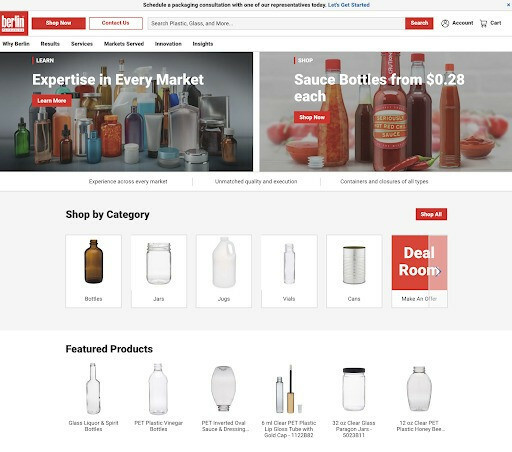
As a fairly complex B2B operation, Berlin Packaging was on the hunt for a B2B ecommerce solution that offered:
- Specialized item attributes.
- Custom inputs.
- An interface with their existing ERP.
- Custom shipping and handling abilities for customers that would improve the overall user experience and streamline processes for them, too.
Since switching to BigCommerce, Berlin Packaging has already seen a substantial lift in conversions — as much as a 27% increase. They've also seen an increase in orders and demand revenue as well.
United Aqua Group.
In 2020, United Aqua Group, a collaborative of residential and commercial swimming pool and spa builders, was looking to shift away from its previous platform, NuORDER, to a platform that offered more B2C-like experiences. With a catalog of over 400,000 products, United Aqua Group sought a platform that provided site speed, ease of use, ability to customize and consistent performance.

After viewing a demo and seeing the platform’s numerous customization features, United Aqua Group soon landed on BigCommerce. These were just some of the deciding factors that led to the company’s decision:
- Integration to ERP and the ability to pass information from their ERP back into their store.
- Quick loading and improved search.
- Ability to upload order spreadsheets.
- Ability to choose multiple views and multiple shipping addresses.
- Ease of managing categories.
- Ongoing support.
- A dashboard to see purchases for the week and even compare orders from the previous week.
After making the switch, United Aqua Group saw a 284% increase in customers, a 539% increased conversion rate and a 336% increase in revenue.
Tradelink.
As a company ingrained in tradition and experience, Tradelink, Australia's oldest plumbing merchant, wanted to pursue new technologies to modernize its services. To help achieve this modernization, Tradelink wanted to adopt an ecommerce platform that could stay up to pace with the Tradelink’s scale and scope, considering the company had over 200 branches across Australia, 300 cars in operation and 1300 team members serving its customers.

With limited ecommerce functionality on its previous backend system, Tradelink sought a platform that would provide speed, flexibility and connectivity. After considering their options, Tradelink eventually switched to BigCommerce, which offered the company quick response times, fast page loads, accurate search functionality and mobile-readiness.
With third-party apps like consumer reviews with Trustpilot, marketing automation with dotdigital and merchandising with Klevu, BigCommerce was able to provide Tradelink with a versatile online storefront that rivaled its in-store experience.
After migrating to BigCommerce, Tradelink experienced a 346% increase in customers, a 373% increase in orders and a 338% increase in revenue.
Make It Big 2022 Conference
Watch our Make It Big 2022 conference and get ready to level up.
WATCH FOR FREEThe Final Word
With 32% of U.S. B2B professionals claiming ecommerce to be the most effective sales channel — compared to 23% in favor of in-person channels — it’s no doubt that B2B ecommerce is making headway. And with B2C businesses already moving quickly through the digital space, it’s likely the B2B industry is not far behind.
Whether you’re looking to launch a B2B business or want to shift your current business online, you’ll be pleased to find that there’s no shortage of ecommerce platforms and capabilities available for the B2B community. Although going digital may be out of your business’s comfort zone, the benefits of ecommerce far outweigh the initial expenditure: access to new markets, increased conversions, improved customer satisfaction, centralized data — and the list goes on. So, if your B2B business is still stuck in legacy processes, it might be time to set aside outdated misconceptions and begin embracing the future of B2B ecommerce. Start exploring BigCommerce B2B solutions today so that you can prepare for the next wave of B2B ecommerce growth opportunities.
FAQs About B2B Ecommerce
What is the difference between B2B and B2C ecommerce?
B2B ecommerce is the selling of goods from one business to another business, whereas B2C ecommerce is the selling of goods from businesses to individual consumers.
Due to the nature of B2B ecommerce, B2B transactions typically involve high-value, low-volume sales and fewer buyers. Since B2B transactions are often unique to each customer, price points can be negotiable, and the sales cycle often takes longer than a typical B2C transaction, since there is more money, more product and more decision-makers involved.
On the other hand, B2C transactions are usually low-value and high-volume and serve far more buyers. Just like you can’t negotiate the price of bread at the grocery store, almost all B2C sales are non-negotiable, however coupons and other discounts may be available. And since transactions are typically for less expensive goods, the sales cycle is rapid.
How is the B2B buyer journey different from that of B2C?
Broadly speaking, B2B transactions are often characterized by higher involvement, and B2C transactions are characterized by low involvement.
Since B2B transactions often involve higher-value goods and services, there is often more risk involved, and therefore the decision-making process is much longer than that of B2C. As a result, purchasing decisions must go through several people and opinions before being approved.
On the other hand, with B2C commerce, a customer is often purchasing products for themselves or a household, so there are normally only one or a few people involved. And because the cost of B2C goods and services is much lower, the sales cycle is often rapid and much less risky.
That being said, many B2B buyers are now seeking B2C-like journeys, including omnichannel, automated and personalized experiences.
What is the B2B ecommerce market size?
The global B2B ecommerce market is forecasted to reach $1.8 trillion by 2023, which accounts for 17% of all B2B sales in the U.S. — up from 13% in 2019 and 14% in 2020. In addition, the global B2B ecommerce market in 2020 was valued at $14.9 trillion, which was over five times that of the B2C market.
Do you have to be a supplier to sell B2B online?
No, you do not have to be a supplier in order to sell B2B online. While supplying resellers is a popular type of B2B ecommerce, there are several other types of B2B ecommerce businesses, including wholesalers, distributors and B2B2C companies, and many online brands cater to both B2B and B2C customers.
How are B2B payments made?
Although historically relying on paper-based, manual processes, the B2B payments ecosystem has recently shifted toward cloud-based, automated payment systems. This significantly simplifies the B2B transaction process and makes buying and selling both faster and more efficient for businesses and customers.
Amid the changing landscape, B2B businesses have seen a decline in paper checks and a rise in smart payment options such as contactless and remote payments. And through collaborative commerce, payment providers and fintech companies have worked together to build more automation and reduce friction in the B2B payment process.
Among other methods, B2B businesses can make transactions through flexible payment options like buy now, pay later and virtual cards, much like in the B2C space, and the industry has even seen a trend toward AI, blockchain and cryptocurrency.
How can a B2B ecommerce website support custom ordering?
With B2B customers and wholesalers, the possibility for custom orders is much higher than for a B2C site.
Thanks to custom quoting tools, unique variants and segmented customer groups, B2B businesses can allow customers to send in a PDF quote 24/7, then evaluate the quote and get back within regular business hours if the unique order can be filled.
Then, your B2B business can place that customer in their own unique customer group so that the next time they order, the customer won’t have to go through the quote engine. Instead, they can simply click and check out the item that is made specially for them.


